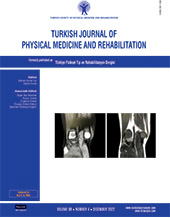The effect of oral baclofen and botulinum toxin treatments in hemiplegic spasticity on the nociceptive flexor reflex: A randomized clinical trial
Patients and methods: A total of 29 spastic hemiplegic patients (20 males, 9 females; mean age: 52.9±10.1; range, 27 to 64) with Modified Ashworth Scale (MAS) grades 2-4 were included in the prospective, randomized study between May 2018 and March 2019. The patients were divided into two groups: the BT-A group consisted of 15 patients that underwent a BT-A injection and the baclofen group consisted of 14 patients treated with baclofen. Modified Ashworth Scale, Visual Analog Scale (VAS), Barthel daily life activity index, and NFR threshold values were used in the evaluation of the patients before and after the treatment at the sixth week. The motor evaluation of the patients was performed using Brunnstrom motor staging.
Results: In both groups, MAS and VAS values decreased significantly compared to pretreatment (p<0.05). There was a significant decrease in ankle MAS score (p<0.001) and a significant increase in Brunnstrom hand recovery stages in the BT-A group compared to pretreatment (p=0.020). While the NFR threshold statistically significantly increased in the baclofen group compared to pretreatment (p=0.007), there was no significant change in the BT-A group (p=0.669).
Conclusion: These results suggest that BT-A injections do not cause a significant change in the NFR threshold in the treatment of spasticity.
Keywords : Baclofen, botulinum toxin type A, electromyography, spasticity, stroke
















